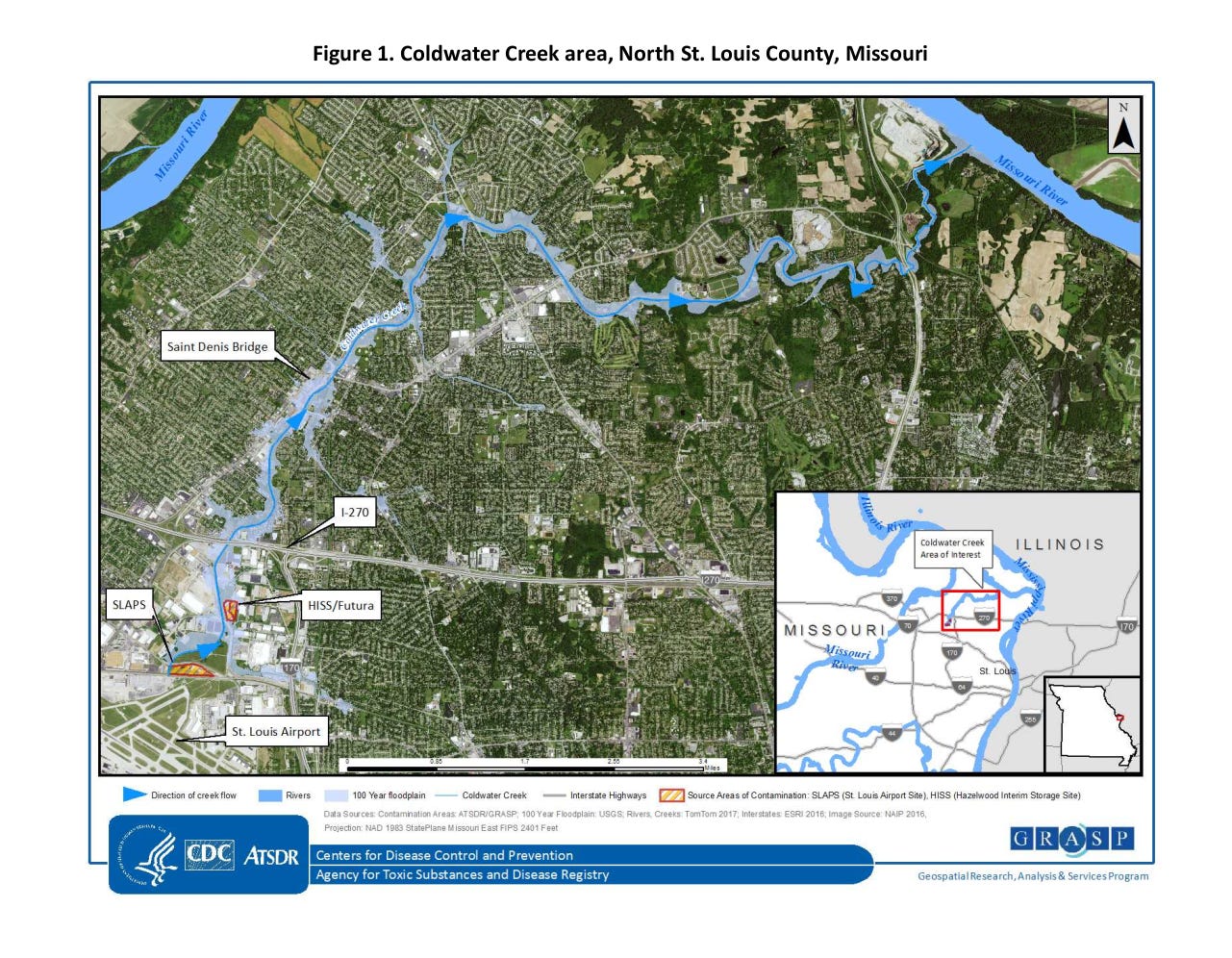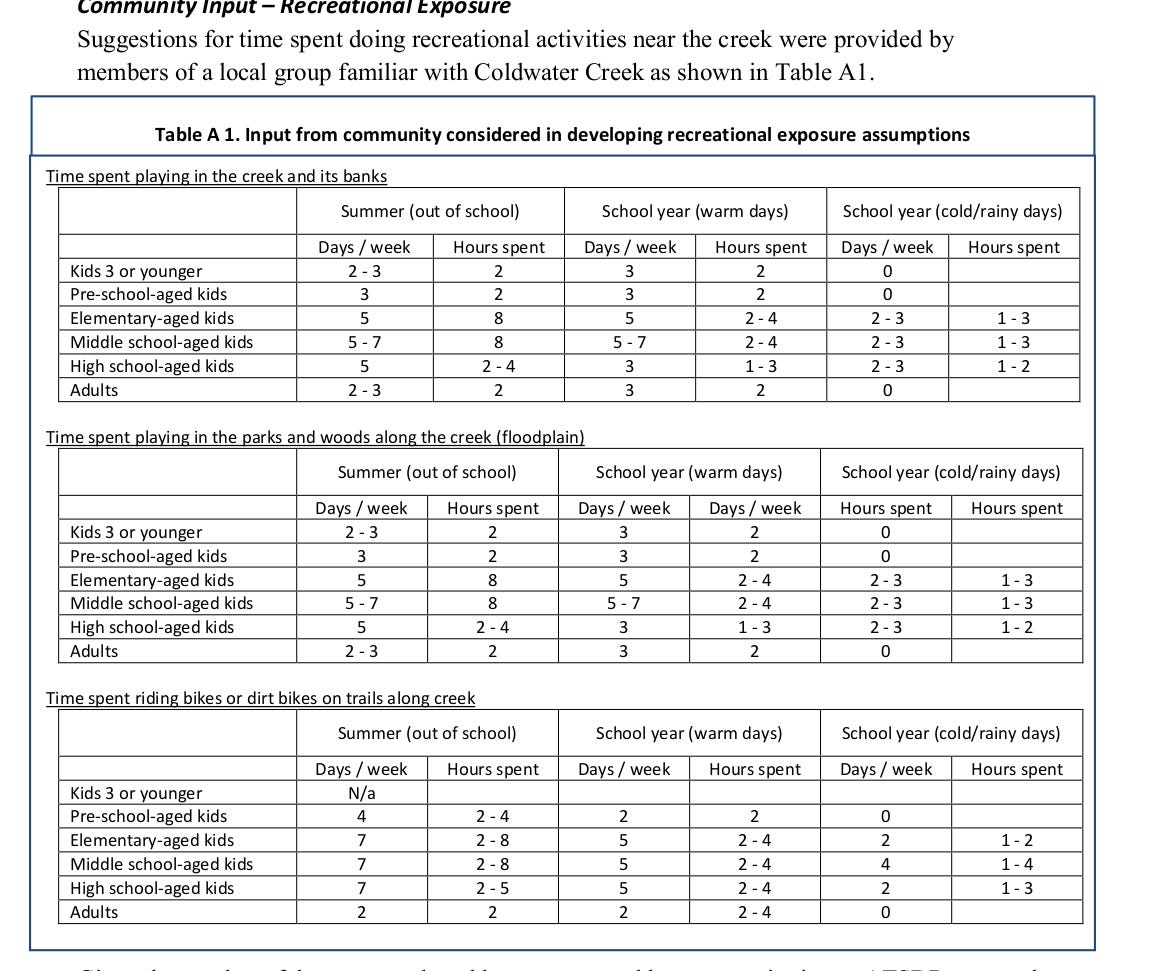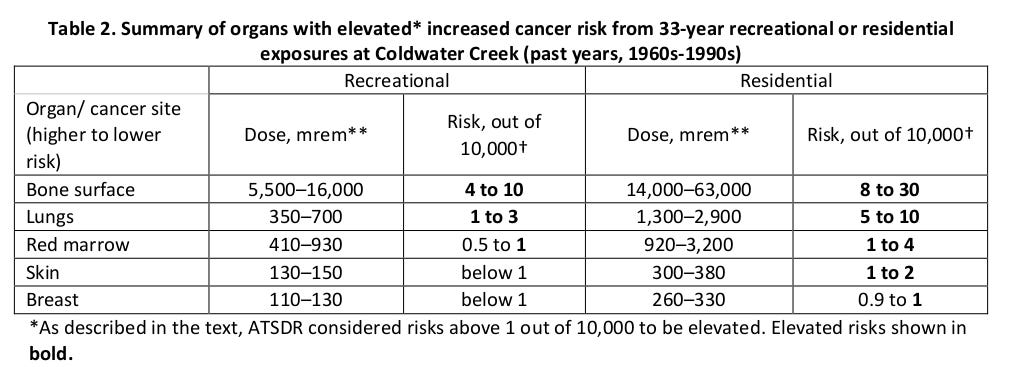Cold water on Coldwater Creek
This piece is a bit longer than usual; but it is a Shaggy Dog story which by definition is supposed to be too long. No peeking at the punch line.
The History
In the silly but entertaining movie Just Cause, Sean Connery plays a clueless Harvard professor who gets bamboozled by a couple of psychopaths. At one point in the movie, the tough, street smart cop, who has sensed what's going down, calls Connery's character "that idiot from Harvard". The line always gets a big laugh. As a graduate of a little vocational school, just down the street from Harvard, I love that line. I was recently reminded of that scene by the latest product from Harvard which purports to "link" radiation to increased cancer incidence around Coldwater Creek in St. Louis.\cite{leung-2025} It's has garnered lots of incandescent headlines. Here's the background.
Between 1942 and 1957, Mallinckrodt Chemical in downtown St Louis purified uranium ore to UO2 and some of that to UF4 and some of that to uranium metal for the bomb program. The waste and tailings were stored near St Louis Airport at a site called SLAPS in drums and open piles. Runoff from SLAPS drained to Coldwater Creek.
Coldwater Creek is not a tiny bucolic stream. It is a tributary to the Mississippi which drains most of the St. Louis area, Figure 1. In a lot of places, it would be called a river. It winds for 14 miles right through the middle of St. Louis, Figure 2. A lot of people live and have lived near Coldwater Creek. In 1966, most of SLAPS waste was shipped off to Colorado.
Figure 1. Coldwater Creek showing storm drains
Figure 2. Coldwater Creek from the airport to the river.
The contamination of Coldwater Creek has led to a long series of claims of cancer and other diseases, hundreds if not thousands of outraged articles and stories decrying the "poisoning" of the people of St.Louis, culminating in a 406 million dollar federal clean up program, and about the same number of mea culpas. Senator Hawley, a MAGA Republican, has called for a massive expansion of the Radiation Exposure Compensation Act to compensate the "victims".
However, a 2014 Missouri Department of Health and Senior Services study found no statistically significant increase in all cancers nor in bone cancers in the combined eight ZIP codes abutting the Creek compared to the rest of Missouri.\cite{mdhss-2014} This study had a number of obvious shortcomings. It included a large number of people who lived quite a distance from the Creek. It made no attempt to track who actually lived in these ZIP codes between the 1946 to 1966 period when the Creek was most contaminated. It was dismissed by the claimants and the press.
Enter the CDC
So in 2018 at the request of the "community", the Feds stepped in. The CDC Agency for Toxic Substances did a study in which they attempted to reconstruct the worst case dose rate profiles for the people living very near the Creek. The CDC realized they were dealing with uranium mill tailings. There were no fission products. In fact, there were no man-made radionuclides. All the radioactive material at SLAPS was created by Mother Nature.
Almost all this material was U-238 and its daughters. The CDC decided to focus on the three isotopes shown in Table 1. All three culprits are alpha emitters. Alpha particles have no penetrating power. They can be stopped by a piece of paper or the dead outer layer of our skin. They must be ingested or inhaled to cause any harm.
For such radioisotopes, uptake and biological half-life can be at least as important as decay rate and energy per decay in determining the dose rate profile. Uptake is the fraction of the swallowed isotope that is actually absorbed into our blood stream. Biological half-life determines how long that fraction stays in our bodies before it is eliminated in the natural course of events. Since different isotopes will concentrate in different organs, we use the numbers for the main target organ.
Of the CDC's big three, two are radioactively innocuous. Th-230 is insoluble. It has a minuscule uptake fraction. 99.98% of any ingested material will be excreted in a day or two. Combined with a 77,000 year half-life, essentially none of the Th-230 will decay in the body.
U-238 is soluble and has a worrisome uptake, but a short biological half-life of 15 days. Most (70%) of the absorbed material will go to the kidneys. But the 4 billion year decay half-life means the problem will be the chemical toxicity of uranium rather than its alphas. Kathren and Burklin estimate that ingesting 5 grams of uranium over a short period will result in a 50% chance of death due to renal failure.\cite{kathren-2008}. Others put this number as low as 0.15 grams. Cohen calculated that it would take 225 grams of U-238 to give you a 50% chance of fatal cancer from the radiation.\cite{cohen-1977}[p 31] This figure is based on LNT which is outrageously conservative at these dose rates.1 U-238 will kill you chemically long before it can harm you by radiation.
So the problem is our old friend radium. Radium-226 was the focus of our study of the radium dial painters. Radium has a high uptake. Since it is similar to calcium chemically, it concentrates in the bones, where it has a 40 year half-life. From the dial painters and other populations, we know that radium will cause bone cancer for tall enough dose-rate profiles.2
Exposure
To determine the worst case profile, the CDC used input from an unnamed, undefined "local community group". This resulted in the Table 2 estimates of the hours spent "playing in the creek or its banks", "riding bikes or dirt bikes on trails along the creek", and "time spent digging in the dirt."
Table 2. Time spent in and around the Creek per "local group familiar with the Creek"
When I look at some of these numbers, such as 3.3 hours per day riding bikes, they strike me as way high. I spent an active childhood with 8 siblings on a property whose back boundary was a creek. These were not my numbers nor my brothers' numbers. They look more like total play hours, which would be mostly baseball or football on an open space somewhere or basketball on pavement. But this is from a concerned community group, that has claimed the creek is poisoning all in its vicinity. So we accept their "suggestions" as fact.
Not only did these kids grovel in the creek dirt a lot, they ate a portion of it, Table 3.
Table 3. Dirt ingestion per CDC
In my childhood, we boys spent some time right next to or in the creek, skipping stones, and playing war games. But at no point that I can recall did we eat any of the dirt or drink any of the water. The sisters spent next to no time next to the creek. They had much better things to do like playing house. This was the 1950's.
Contamination
Next step is to estimate the soil contamination numbers. They used Th-230 as their indicator. The highest Th-230 contamination was an area that the CDC dubbed Hot Spot 3. They took the highest sample from that locale, and then used a algorithm called ProUCL to convert this mean/median(?) to an estimate of the upper 5 percentile of the contamination. I think they repeated this process for Ra-226 and U-238 to get their top end contamination of these isotopes, although I found the report unclear on this issue.
Top end dose rate profile
Once they had the exposure and the contamination, the CDC did a nice job of trying to estimate the worst case dose rate profile:
We calculated intake by ingestion and by inhalation in picocuries (pCi) for each year of life, assuming exposure begins at birth and continues for 33 years [43]. Each year has a different intake since age group, exposure assumptions, and intake assumptions change throughout life.\cite{cdc-2018}[p 18]
But since the CDC adheres to LNT, after all this work, they throw away everything but the cumulative dose, apply ICRP's LNT based cancer incidence risk factors and they finally have their maximum cancer incidences, Table 4.
Table 4. CDC's worst case dose and LNT cancer incidence for Coldwater Creek
Unsurprisingly, the main problem is bone cancer. The CDC also found an "elevated" (higher than 1.0e-4) incidence of lung cancer. This must have come via inhalation from the dust from all the bike and dirt bike riding near the Creek. When I was a kid, nobody had dirt bikes. I'm not even sure they had been invented. And we rode our fat tired, single speed Schwinns on the street or sidewalk. They were not great mountain bikes.
The CDC is surprisingly unimpressed by these elevated risks. They end up recommending against any special screening of past Creek residents on the grounds that it will do more harm than good. Perhaps this is because their highest cumulative dose to the skeleton was 63,000 mRem (630 mSv) which, as the report candidly points out, is 250 (actually 285) times less than the lowest dose at which we detected clinical bone cancer in the dial painters,\cite{cdc-2018}[p 22] which the CDC puts at 18,000,000 mRem (180,000 mSv).3
SNT at Coldwater
The CDC does not tell us the worst case dose rate profiles that they so painstaking constructed. But we can make a stab at the bone cancer profile. There are some strong similarities between this profile and the radium dial painters, They are both mostly Ra-226 which was mostly ingested over a 10 to 15 year period, and then slowly left the body. So we blithely use the same code we used for the dial painters but with a total dose of 630 mSv over 33 years. Figure 3 shows the resulting profile.
Figure 3. GKG's Guess at the CDC's Worst Case Creek Profile. The CDC should not have cut the analysis off after 33 years. Running the numbers out for say 70 years, would have close to doubled the incidence.
It is extremely unlikely that any kid actually incurred this profile. And we know that SNT badly overestimates the dial painter cancers. But accepting all these pessimistic assumptions, the SNT cancer incidence is 4.8e-6, which translates to a Lost Life Expectancy of about 15 minutes.
Back to Harvard
The Coldwater Creek saga refuses to die. Despite CDC's heroic attempt to produce an extremely pessimistic worst case profile, the results were disappointing and the study was regarded as a bit of a cover up. So Harvard stepped in. Harvard does not do dose rate profiles. They found a data base of childhood addresses from a 1950 tooth collection effort aimed at measuring bomb test fallout. They sent out questionnaires to these senescent old folks, asking them if they had been diagnosed with cancer and what type. According to these self-reported numbers, overall cancer incidence dropped as the childhood residence moved farther away from the Creek.
The Harvard researchers realized that this drop off could be the result of all sorts of causes. But they came up with a clever way of countering that. The authors were able to garner all their headlines because the decrease in certain cancers was a little faster than in other cancers. The faster decrease was in radio-sensitive cancers. Ergo, the Creek's contamination with uranium mill tailings had caused an increase in cancer in the kids living near the Creek.
Finally, we get to the punchline. The cancers that Harvard deemed radio-sensitive are thyroid, breast, leukemia, and basal cell. Other cancers were termed non-radio-sensitive. But Harvard's radio-sensitive cancers are bomb fallout and nuclear power plant release cancers, which are caused by fission products such as radioiodine in the case of thyroid cancer, and external gamma mostly from radiocesium in the case of breast cancer. There were no fission products in the Coldwater Creek contamination. The "radio-sensitive" cancers for a mine tailing runoff are bone cancer and possibly lung cancer. The Harvard authors were so clueless they did not understand the difference between bomb fallout and mill tailings. They make Sean Connery's "idiot from Harvard" look like a genius.
Inexplicably, the CDC study makes no mention of uranium's chemical toxicity. Instead, they say they "did not identify any non-radiological chemicals that would be expected to contribute substantial risk from recreational or residential exposures". The Creek drained an industrialized area at a time when it was routine to dump chemicals into watercourses.
Mallinckrodt and the AEC realized that Ra-226 was the problem. Radium is separated out early in the purification process and with it almost all the gamma in the U-238 decay chain. The radium was packed in drums, while the U-238 was stored in open piles. The drums would leach into the Creek far more slowly than the piles, which is probably why CDC used the innocuous thorium contamination as their marker for how bad things were.
The GKG lowest dose dial painter number is 245,000 mSv. Close enough.









Beautiful
Danes detailed, as usual. Well done!